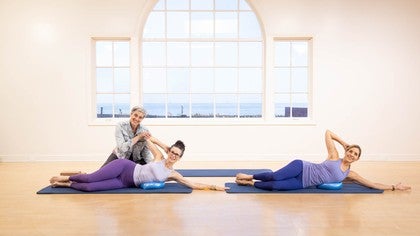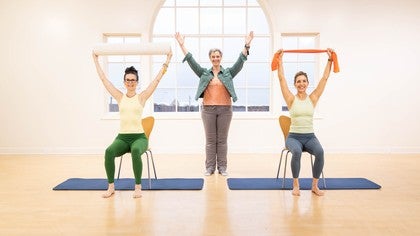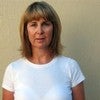Description
About This Video
Transcript
Read Full Transcript
I'm Joy, and in this class, we are using some props. Today, we are using a yoga block, a resistance band, and a ball. Now you don't need any of these if you wanna join and participate today, you could also have something as simple as a beach ball in place of the ball that we're using, a towel or a belt in place of a resistance band, and just even a bolster or a rolled-up towel in place of a yoga block. So join us even if you don't have these props. All right.
So since we do have some props available to us, I'm going to ask Kristen if she wouldn't mind taking that band and wrapping it around, and notice she took the band from the front, she wrapped it around the back and she's gonna hold the band in her hands. And for Tiffany, she's gonna have these yoga blocks handy. But for the first part, we're just gonna start with breathing. So Tiffany, I'm gonna ask you to just put them down alongside you and hang on until we move a little farther into our little workout today. So today's idea is restoring, right?
Now for restorative, very often, we think it just means, "Oh, I just get to chill out and breathe." But here in this instance, the idea is to restore our vitality, to return us to a place in which we can move forward and progress, and to tap into ourselves in such a way that we have lots of options open to us in terms of movement. So today will be some breathing and restoring and some restoring and vitalizing, okay? We're gonna start though with a calming breath. What's really lovely is right behind me is an ocean, and we're going to use that as our rhythm for our breath. So here we'll start with a four-sided breath.
So it's inhale for count of four, exhale for a count of four, hold for a count of four. Inhale (inhales), pause at the top, exhale, pause at the bottom. Now these are called four-sided breaths, but as you're doing this, I'd like you actually to think more of a circular breath, right? Not unlike the waves that are out there; there's a little pause from when one comes in and the other goes out. And let this breath really just center you.
And the other thing I'm gonna ask of you is just notice what your feeling and experience is right now. Did you just rush in and you're just calming yourself down? Did you not wanna do this class and now you're finding yourself sort of just opening your mind to it? Whatever that experience is for you, go with it. Okay.
So now the beautiful thing about breath is it charges our internal rhythms, right? And that's gonna prep us for the external movements. So here, let's add now some movements to the breathing. I will ask Tiffany to hold onto these bricks. Now these yoga blocks have some weight in them.
That's why I want her to use them. You can use anything. You could take two bottles filled with water or partially filled with water. You can take your paper towels. You could take anything that's gonna give you some feedback in your hands.
So elbows are bent and alongside your body. Now, when you're inhale, I want you to reach out (inhales). Exhale, bend your elbows alongside your body, even get them a little behind you. Inhale, reach out and exhale. Good. Let the breath drive the movement.
Kristen's got a little bit of resistance here so as she reaches out, it's gonna make her torso wanna move. She's gonna stay stable. And for Tiffany here, she's got a little bit of weight in her hands so that she's driving forward and controlling as she comes back. Great. So from there, let's take this into a little bit of a rotation.
Take the right arm forward and pull the left arm back. Keep your eye gaze forward, and then switch and switch. Now, notice as you're rotating your torso, how it might be challenging to keep your eye gaze forward. But think about what you're doing when you're walking, when you're running, right? That the eye gaze stays forward, but the rest of the body is rotating underneath you.
Nice. Now stop for a second. And let's do a rotation where you're actually looking in the direction you're rotating to. Now, here's what I want you to do. Turn to your right, bend your right elbow, look over your right shoulder, opposite arm lengthens. Good. Now go the other way.
Good. Do two more of these. And then I wanna add something to you because I think it's gonna help your rotation anywhere you are. Good. When you're done with those two, hold it. Now we're gonna do the same rotation, but instead of that rotation happening, because you've decided you're looking your eyes in that direction, I want you to imagine you're turning the back of your head in that direction.
So the rotation happens from behind you. And I don't know about you, but when I get that rotation from behind, I get farther into it. What I like about the band is the band is actually helping Kristen find that back body relationship. And it's giving her more of that rotation through her ribcage. What I like about the blocks or a little bit of weight, is there's some feedback to work into as Tiffany rotates.
Terrific. And rest. So that's adding some nice gentle rotation. Now, something I forgot to mention, I've got Kristen up on a block. So she's a little bit off of the floor.
I've got Tiffany sitting on the floor and you know what? If that's not comfortable for you, you could sit on something like this box or like a chair. All right, now we're gonna stay seated, but I'm going to ask you both to turn toward your right so that you're side facing to the camera and your arms are out. Again, notice, if I'm on a block, then that gives me a little more space and comfort in my hips. If you're on the floor, I want you to make sure you bend your knees so that you really can be up on top of your sit bones.
Kristen, you can get rid of the band. But notice I have Tiffany and she's got a loop band that's around her arms. You could just tie any band. And again, you could use a belt, just something that you can feel a little bit of pressure out into the arms. Now we started with the rib cage.
We started with the breathing. We're going into the pelvis here. So I just want you to rock back off your sit bones, curling back, hold it very small. Now come on up and sit up as tall as you can. Rock back, draw the belly button in, now right there, hold it, really filling your back body as you sit up nice and tall.
Sit up nice and tall, lengthen through the crown of your head. Good. Rocking back. And then lifting up. Great. Now, adding a little bit to this.
Rock back. I want you to come forward and then I want you to raise your arms up to the ceiling and sit up tall with your arms overhead. Now you're finding the length all the way through the shoulders and the arms, through the fingertips. The arms come forward, curl back. You come forward.
Reach all the way forward, now lift up and sit up nice and tall. Big inhale here, exhale, curl back. Arms forward Reach forward and lift up. Nice. Now stay lifted. Good. So there's some abdominals happening here, right?
But there's also some nice organ work that's happening. Really nice massaging work for the abdominal cavity. Now we're gonna get even a little deeper into the abdominals. Hinge back so that you're on the back end of those sit bones and your feet are gonna wanna come up, don't let them come up. Don't go that far.
Lift up, get taller and go forward over your thighs. (Joy exhales) So here's the deal, sit up nice and tall. You start hinging back, your feet wanna come up, ground those feet. Don't go too far back, it's not about how far you. Get taller as you come up.
Go up, go up, go up, go up, go up, go up, go up. Yes. Now go forward over your thighs. Sit up nice and tall. Great. One more time, hinge back.
It's not about how far you go, lift up. And go forward. Nice. And then you're gonna stack your spine up again. Arms are gonna go down to your side, take off that band. And then the very last thing we're gonna do here is I'm just gonna ask you to power through your arms, adding a little rotation, keep your eye gaze forward.
Find your breath. (Joy inhaling and exhaling) Curl back, curl back, curl back, curl forward. Go forward, go forward, go forward, go forward. Curl back and forward, and back and forward. Last one.
And back. Easy, light. Don't judge it and then reach all the way forward. Straighten your arms out and spine, stretch yourself forward. Lengthen your legs. Lengthen your legs. Lengthen your legs, as well as your arms.
All right, let's have you guys roll up. Now I'm gonna ask you both to lie on your backs, but let's turn you around. Lie back. Kristen's gonna have a ball. She's gonna put that ball under her pelvis, and Tiffany is gonna put a yoga block.
Remember you don't need either of these. If you have a, you know, a beach ball and you can deflate it, and you wanna put that under the pelvis, great. If you don't, you can roll up a towel, you can use a bolster. You could use anything and that's just gonna get the pelvis a little bit higher than the shoulders. Now we'll start with rest pose.
So bring one knee into the chest and then bring the other knee into the chest. Now, because you've gotten into this position, you don't wanna feel like whatever is underneath you is gonna shoot out from under you. So if you need to adjust, please, now's a good time to do that. But here just bring those knees towards you. And very often that's the cue.
Bring your knees towards you. But I want you to go a little bit deeper from me. Bring your thighs towards your chest or your thighs towards your torso. And what that allows the back to do is relax into the stretch. If you pull your knees, it tends to be a pulling action.
If you bring your thighs towards your chest, you get this nice folding. This is terrific if you have low back tightness or issues or you just get outta bed in the morning, you're like, "Oh, I just can't stand up straight." Okay. Now we'll go into a stretch for a muscle called your psoas. If you would both hold onto your right shin, keep that thigh towards your chest as you let the left toes drop down toward the mat, and then let the heel drop. So for someone who is very tight, depending on how high they have the pelvis lifted, this might be as far as they go.
But I know that these guys have more flexibility so I'm gonna ask them to slide their leg out along the floor as far as they can, that the leg is lengthening. Without, when I look at their bodies, them looking all disjointed. Now they're gonna lengthen out through their femur or their thigh bone while they're also pulling in with their shin on the opposite side. And just breathe into that. Every time you exhale, see if you can pull that thigh a little closer to you while you lengthen out the femur a little bit more.
And once you've got a couple of rounds of breath, we're gonna switch sides. You're gonna slide that leg in. Do not let that leg dangle as you slide it in. You just got a nice stretch through the whole trunk into your legs, so you don't wanna wrench yourself trying to switch sides. You bring the opposite thigh in, you drop the toes down, and that length in that leg out.
In this case for them, it's their right leg that's lengthening, their left that's drawing in toward them. Again on the left side thigh coming in toward the chest while the right side is really lengthening out through the top of the thigh, not through the feet or the lower leg, and a few rounds of breath there. Super. When you're ready to come out of that, and you can take your time here, but when you're ready to come out of that, you slide the leg back in, bring both knees in and hold. Okay.
So we'll take this now. The next step, you're gonna put your right foot down on the floor. Now here's the deal. Restorative doesn't just mean rest. It's about restoring the vitality, tapping into the potential, in this case, of our psoas, our trunk and our leg. So what I'm gonna ask you to do now is activate that stretch.
So on your left side, toes down, toes are gonna touch the mat. You're gonna slide the leg out. You're gonna flex the foot and lift. Point your toes, toes down. So now think like a dolphin diving into the water and popping up and out.
And it's down, lengthen and up, and find that flow and that rhythm. You really wanna feel this coming from the ribcage, through the leg and up. So there's this nice charge of energy through that movement. Good. Now take that leg up and hold it up there.
Flex and really energize out through the heel. And we're gonna do something called the keyhole leg. And I want you just to internally and externally rotate. Nice. And then hold.
Now point your foot and then flex. I really want you to articulate, push through the ball of your foot and then reach through your toes, and then drive through the back of the leg to flex. Listen, ankle work is hugely important to balance, hugely important to gate, hugely important to the quality of any kind of running or activity that you do. Take your time with your ankles. Even here, circle those ankles around, reach for the ceiling.
You will notice your feet get really tired, really fast, which is why I'm actually talking and making these guys go through this movement. Reverse your circles if you haven't already done that. Good. Super. Now lower the leg to 45. Flex your foot.
Turn out, turn in, turn out. You've got a lot more movement out than you do in that's for sure, but see if you can get that big toe to really point towards your midline. You may get some cramping in your hip. If you do that, you can soften your knee or you can raise your leg up higher and hold it there. Now point and flex again, articulate through that foot.
I really wanna see that ball of that foot drive forward to the heel and then the toes, and then the pulling back. And also here make some circles. And the other direction. Super. You're gonna bring that knee in to your chest.
Bring that foot down to the floor and then we'll do the other side. Okay, from here, we're gonna go into that psoas stretch on the other side. so let's have you hold onto your left leg. Your right leg comes down, lengthen it out along. Good, and reach.
Now remember it's left side is coming in toward the body. The right side is lengthening out through the quad. On your exhale, feel that opposition and that oppositional stretch. Good. Now, when you're ready to come out of this, and please do take your time if you wanna pause with this stretch, but when you're ready to come out, you're gonna glide that leg in, bring the leg toward you.
Now we'll use our left foot as our stabilizing foot. They're gonna place that left foot on the floor, arms alongside the body, and we're gonna go into sort of that dolphin where they point their toes, reach the leg out, lift the leg up. And it's down. Reach and up. Let's reset that so I've got these guys working together.
So bend your knee, put that in. Toes down. Lengthen out and up. Find your rhythm; it's down, out, and lift. Down, out, and lift.
Can you ride your breath as you lift? Give it energy. Don't judge it. Don't expect anything of it. Just reach and lift, and hold. Beautiful. Right?
So again, not only do we wanna tap into the psoas, and not only do we wanna stretch through the trunk, we wanna also open the hip and activate at the same time. Okay. So we've got that little pump going. Now let's take the leg straight up to the ceiling, flex through the heel, and let's have you internally and externally rotate. So this is called keyhole leg. This comes from the Kathy Grant work through The Heritage Training in Cara Reeser, highly recommended if you have a desire to learn more.
And then come back center. Now I want you to point your toes and flex, pull your toes towards you. Articulate through the foot. These feet are super important. Do that a couple of more times and then add circles here.
It's amazing how tired these muscles around the ankle get. And you know, what do we tend to strain and stress the most when we're walking and running? Are our ankles. This is a great way to prevent that. Awesome. Take the leg down to 45 degrees.
Hold it there. See if you can get a little bit of tracking through the knee by pulling up on the quad muscle while you're reaching out through the heel and find that internal and external rotation. Again, you'll notice you have more external rotation, that's normal, than you have internal rotation, but see if you can find that big toe, finding your midline. Also try not to hike at the hip or shorten at the waist. Great. And here again, let's articulate through the foot.
Push it away, pull the toes towards you. Push away, pull them towards you. Get the anterior part of your shin, the front of your shin, active, hugely important for balance and control. And then, now circle around the ankles. And the other direction.
Good. Terrific. Now bring that knee in and that foot comes down and finds the floor. Lift up the pelvis, take the block out from underneath. Good.
Let's have you come up to sitting, whatever way you wanna come up to sitting. Again, don't judge it. Great. Okay. So we just released the psoas, stretched the trunk, stretched the legs.
Now, let's take this into some lateral work and into a muscle called our quadratus lumborum, which is notorious to spasm, especially with tight backs and any issues with lower back. So you're gonna take a ball or something that is compressible. Again, it can be a rolled-up towel. It could be some foam, anything that you can get under the rib cage that you can just get a little bit of a lateral bend over. I don't want this to be a huge thing, but something that's gonna give you a little lift off the ground that you can breathe into.
And that's the first thing, breathe into it. In this case of the ball, what's lovely about a ball underneath the rib cage is the ball has an elastic quality to it. The ribs have an elastic quality to it. And so as you breathe into it, the ball gives a little gentle pressure back into the ribs and you get some nice release. What are we working on releasing?
While in the back here, behind the waist, is a muscle that is really hunkered down underneath your larger muscle, that is your lat, and it can get really strangled and tight and cause back issues. Taking a moment to breathe into it is huge to help let it go. The other thing that is really lovely here is to add a little rotation. So as these guys both exhale, they're gonna rotate toward the floor. Inhale, they're gonna come on back.
You will notice Tiffany has her hand over her head. She has that flexibility. You will notice Kristen has her hand out in front of her. All of this is okay. You could also have your hand just to your side in front of you or even on top of your head.
The pelvis does not move. It gives a nice leverage against the rotation and the stretch, and this should feel lovely. Don't wrench into it. Don't pull on it. Just go with the breath and the movement. Good. So now that quadratus lumborum, right?
We're wringing it out, we're stretching it. Now let's put a little vitality into it. Let's activate it. I'm going to ask you to take your bottom hand, guys, put it on the floor. Your palm could either face down and press into the floor. Your palm can face up, whichever you're comfortable with.
The other hand is behind your head. Now you're gonna do a little bit of a lateral side bend, but here's the deal. You're not doing it by pulling yourself up, you're doing it by pressing into the ball. Exhale, press into the ball. Let that be what helps you bring the body up.
So now we're activating into that QL on the right side, but we're also on the side that's down toward the floor, stretching and lengthening it as well. Nice. Just a couple more. These are not intended to be super intense, but just to give you a feeling of activating through the side body. Nice. Awesome. Now let's take this and put you on your belly for a second.
So we're gonna work our way around. Don't worry, I promise you, you're gonna get both sides. I won't leave you half-baked as it were. And the first place I want you to put the ball is at the level of your hips or at the base of your belly. Now I'm gonna put a warning on this: You must be comfortable with this.
If this ball or foam or towel or whatever you have underneath you is too big or too much, take it out or make it smaller, and just breathe into it. What's lovely about this position is the legs are a little bit lower than the hips, it's gonna allow for the back of the body to release. We can get some openness through the sacrum, the lower spine, plus you're massaging the organs and you really can focus on the breath, the exhale, almost as though you're trying to scoop that ball in and up so that it widens across your back. It's just a really nice opportunity to let that back go, only if it's comfortable. Good.
Now, the next thing we're gonna do is we're gonna take that ball and I'm gonna ask them to bring it to the sternum. And here too, placement is gonna be key. Some people like it a little bit higher, some like it just like these guys do, sort of at the base of their ribs. It really means you've gotta be comfortable with your chest and where your chest is with this ball. Now here, also breathe, opening through the upper thorax, allow the shoulders to rise, allow the shoulder blades just to do what they're naturally gonna do here.
And then from this, we're gonna take it then into a little extension. On the next inhale, I'd like you to lift up, feel your arms and your hands pressing into the floor. Your eye gaze goes out toward the window and then come on down and allow your whole back body to wrap around that ball. Right? So lengthen, nice and neutral through the neck until your eye gaze starts to come up along the wall and let it go up, go up, go up, go up, go up, and you can now come into whatever extension is comfortable for you.
And then come on down. Now on this last one, right? Let that eye gaze lead you. I want you to focus on that ball and see if you can almost push that ball also toward the wall. And then come on down.
Great. Now I promised I wasn't gonna leave you half-baked, so now you gotta turn to your side. You'll both face me. Knees are bent, and this is lovely because now you'll get an opportunity to see this from the back of the body. If you have the flexibility, the top arm can go overhead.
It can go in front of you. It could be even on top of your head. And if you need to, if there's just not that flexibility, put it right on your sternum. But the most important part here is to breathe. And I'm gonna ask you to breathe into the ball.
So if you could imagine, here it's Tiffany's right lung. It's pressing into the ball. That ball presses up into her. It really creates a nice relationship in the breath and the breath patterning. Good.
Now we'll add some rotation to that. I'm actually gonna put my hand on Tiffany's hips so that you can see sort of the oppositional rotation that's happening here. And that's part of what's helping us to wring out this muscle right in here, called the quadratus lumborum. If you are working too hard here, you're gonna affect the opposite. And you're gonna get this guy a little too protected.
We really just want him to relax, let go, and then come back. And I can't believe I just gave your quadratus lumborum a gender. (onlookers laughing) And then one more time. Good. Now let's do a little bit of a side bend, shall we? So put that top hand behind your head.
How do I want you to do that? Tiffany, are you okay? I'm gonna put my hand on you here. I want you to see this. She's gonna press into the ball, and by pressing into the ball, that's gonna turn her up.
Yeah. And then come on down. So she's not pulling or wrenching herself up. That's again, gonna get the quadratus lumborum a little too overactive and fired. Instead, it's pressed down into the ball. That's gonna turn her up.
Nice. And one more. Super. Now let's have you rotate forward and then we're gonna take you onto all fours. And if it's available, you're gonna come all the way up to high kneeling and you can face each other.
Now you're gonna notice, Kristen is starting to roll up her mat. So when I go into high kneeling, I don't cramp in my feet, but you might cramp in your feet. So by rolling up the mat, they're giving their shins something to feel. The other thing that is sometimes helpful is if you have something like a box or a chair in front of you, it just gives you a sense of where your front body is. And now everybody put the heel of your hands on your hip bones, your fingertips on your pubic bone.
And what I want you to find is an alignment between your pubic bone and the heel of your hands. It might not even almost feel like your pubic bone is coming forward of your thighs. And here now, we're all gonna lean back, right? Just find the stretch on your thighs and stop. Please, don't go too far and then come on up.
Good. Now take your arms out in front. Keep that pubic bone and that feeling of it being forward of your thighs. Lean back, find this nice long stretch, and then come on up. Good. Now add arms, lean back and raise the arms up. Overhead, up, up, up, up, up, without arching the back.
Sit and come on up. So we're doing this in neutral and I'm not looking for extension here. You're gonna have a come on back, arms go up. Stay connected through your core, arm lift up. Yes, this is core work.
Yes, this is a big stretch in your quads. Yes, it's a lot of work. One last time, lean back. And then arms up, and lift up. Right.
And if you could tell by their faces, this is challenging. So if this is challenging for you, (laughs) that's okay. And is it restorative? The answer is yes. Let's put you on all fours and let's just end with a nice big cat stretch.
So here, I want you to think head and tail and fold yourself under. Think nose towards your pubic bone, lengthen out. Now you guys start to look at each other, lengthen out, Kristen, lengthen out, start to look at each other and now let your eye gaze go up and then take your nose under and imagine your nose trying to find your navel, and then lengthen out. Look at each other and look up. Last time, and curl.
And now lengthen out to a nice long spine and sit back into child's pose. So restorative doesn't always mean we're just gonna rest. Restorative can mean that we're gonna tap into our strength and our potential and create some vitality.
Empowered Aging: Pilates for Menopause
Comments
You need to be a subscriber to post a comment.
Please Log In or Create an Account to start your free trial.


















